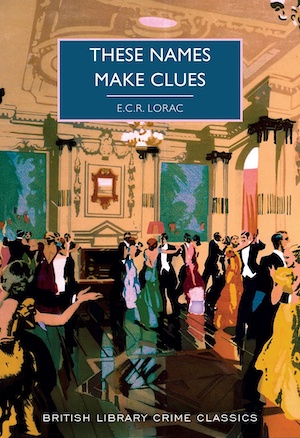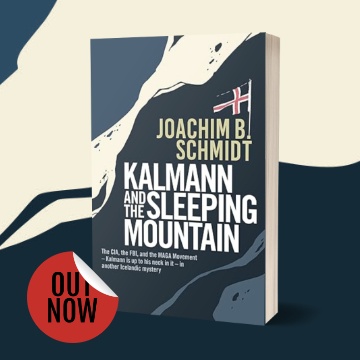
First published in 1937, the same year that ECR Lorac was elected a member of the prestigious Detection Club, These Names Make Clues is a cerebral detective story that is perhaps the most in keeping of all Lorac’s books with the conventions of the Golden Age of Murder. Principally a ‘closed circle’ mystery that relies heavily on cryptic clues, pseudonyms and literary influences, it provides sometimes surprising insights into middle-class artistic life during the interwar period and pokes fun at the publishing world while also portraying a convoluted crime that taxes even the best Scotland Yard has to offer. The book has recently been republished by The British Library.
In an opening section that neatly captures his phlegmatic yet sporting personality, Chief Inspector Robert Macdonald, Lorac’s main series detective is settling down for an evening by the fire reading a travel book by Peter Fleming (whose younger brother Ian would soon eclipse him in terms of both literary output and popularity). First, however, he has to open the letters that arrived while he was at work. Among them, to his initial befuddlement, is a rather grand-sounding invitation:
“Mr Graham Coombe and Miss Susan Coombe invite Chief Inspector Macdonald to join in a Treasure Hunt. Clues of a Literary, Historical and Practical nature will be provided. It is hoped that detectives, both literary, psychological and practical, will compete in their elucidation.”
Accompanying the invitation is a letter from Graham Coombe that references a somewhat embarrassing conversation he and Macdonald had a while back, during which Macdonald held forth on the impractical nature of thrillers, unaware at the time that Coombe is a publisher of crime thrillers. Although Macdonald is initially reluctant to attend, a chance visit by his friend Peter Vernon, a journalist who happens to know the identities of a couple of the other invited sleuths, convinces him that he should accept Coombe’s challenge to measure his wits against the thriller writers who may be competing.
At the party, Macdonald discovers that all of the attendees, save for Graham and Susan Coombe, have been assigned literary pseudonyms, with one of the aims of the treasure hunt being to unmask the other competitors. While everyone seems keen to discover who the real detective among them is, Macdonald – or Izaak Walton, as he’s known for the evening – appears to take an early lead in the treasure hunt, moving from room to room around the Coombes’ house as he solves clue after clue.
As Martin Edwards notes in his informative introduction to this edition, the setup of the Coombes’ party is reminiscent of the scenarios of other great Golden Age mysteries, particularly Agatha Christie’s Cards on the Table, which sees Poirot invited to play bridge with both skilled detectives and murderers who have proved skilled at evading detection, and it never bodes well. Sure enough, just as Macdonald is swapping clues with a fellow treasure seeker, the lights go out and chaos temporarily reigns in the house.
When the power is restored, it soon becomes clear that one guest, who has been designated Samuel Pepys for the duration of the party, is missing. Macdonald and Coombe go in search of Pepys – whom Coombe reveals to actually be the bestselling detective story writer Andrew Gardien – finding his dead body in the small telephone room on the ground floor. Although the cause of death is at first assumed to be heart failure, Macdonald quickly becomes suspicious and launches a full investigation. However, when another death is discovered shortly afterwards, this one undoubtedly a murder, the case becomes even more complex and Macdonald has a real puzzle on his hands trying to prove how the deaths were brought about and who could have been responsible.
These Names Make Clues is a terrific example of the puzzle mysteries that were so popular during the 1930s and 1940s, although Lorac departs somewhat from the ‘rules’ of the Detection Club in that she arguably doesn’t provide quite enough information to ‘play fair’ and allow readers the chance to solve the crime before Chief Inspector Macdonald. There are clues sprinkled throughout the story, however, which should prove particularly enlightening to fans of cryptic crosswords and anagrams. While the death of Gardien seems likely to have been the work of one of the treasure hunters, who form a convenient ‘closed circle’ of suspects in the Coombes’ house that night, the second death is a far more perplexing business and something more akin to a murder thought up by John Dickson Carr.
While the story doesn’t require a trigger warning, Lorac does highlight (perhaps unconsciously) the day-to-day sexism that women of the period faced regardless of how successful they were in their chosen profession as well as the damagingly judgemental nature of the male-dominated society. The small differences in society then versus society now that appear as the story progresses, such as the apartment building for only female tenants (which is dismissively referred to as a ‘pussery’ or ‘hennery’ on several occasions), add an interesting layer of social commentary to the story, elevating it from straightforward detective story to something with more depth.
The various references to and inspirations drawn from the Detection Club render These Names Make Clues a work of particular interest to fans of the greats of Golden Age crime writing. Martin Edwards suggests that Gardien may have been inspired by John Rhodes – in terms of his physical appearance and literary output, not the dodgy aspects of the character – which is an interesting prospect, although the suggestion that Rhodes may have provided Lorac with the idea for the story seems a little disingenuous.
A twisting, turning mystery with a host of viable suspects, more than its fair share of red herrings, a savvy detective and, ultimately, a satisfying conclusion, These Names Make Clues is an example of ECR Lorac at her best. There is plenty for puzzle fans to untangle, albeit maybe not as quickly as Chief Inspector Macdonald, who would feature in over 50 mystery novels.
British Library Publishing
Print/Kindle
£6.95
CFL Rating: 4 Stars









